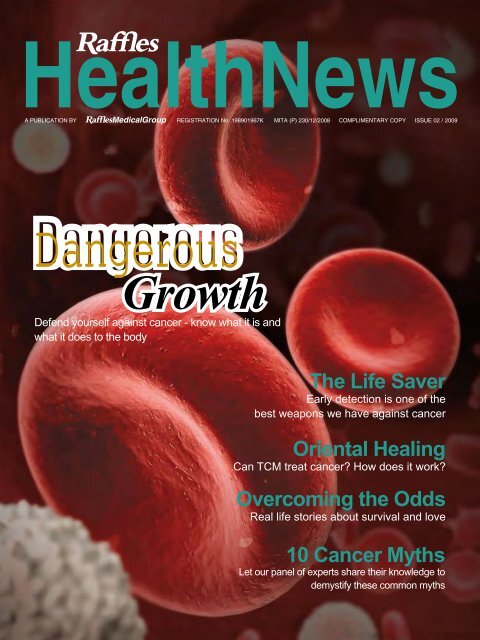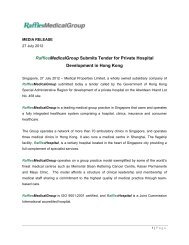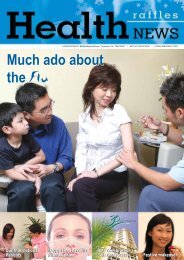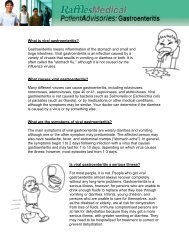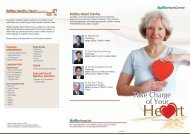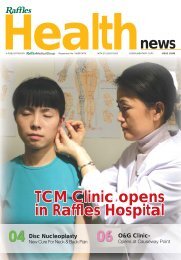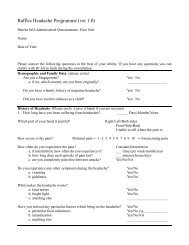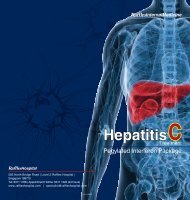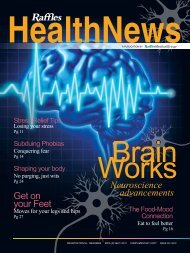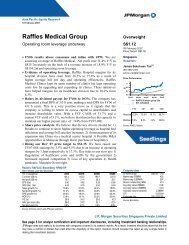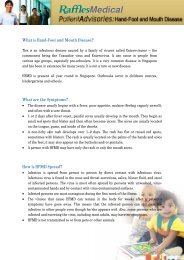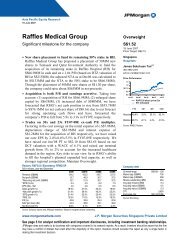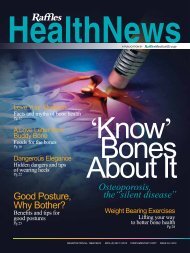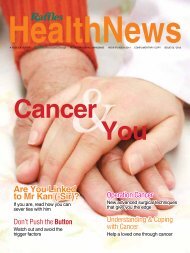Dangerous Growth - Raffles Medical Group
Dangerous Growth - Raffles Medical Group
Dangerous Growth - Raffles Medical Group
You also want an ePaper? Increase the reach of your titles
YUMPU automatically turns print PDFs into web optimized ePapers that Google loves.
A PUBLICATION BY REGISTRATION No. 198901967K MITA (P) 230/12/2008 COMPLIMENTARY COPY ISSUE 02 / 2009<br />
<strong>Dangerous</strong><br />
<strong>Growth</strong><br />
Defend yourself against cancer - know what it is and<br />
what it does to the body<br />
The Life Saver<br />
Early detection is one of the<br />
best weapons we have against cancer<br />
Oriental Healing<br />
Can TCM treat cancer How does it work<br />
Overcoming the Odds<br />
Real life stories about survival and love<br />
10 Cancer Myths<br />
Let our panel of experts share their knowledge to<br />
demystify these common myths
CancerCentre<br />
CANCER RISK<br />
SCREENING<br />
Assess your risks early<br />
<strong>Raffles</strong> Cancer Centre offers a cancer risk screening programme that addresses the concerns of individuals.<br />
The programme is unique for the following reasons:<br />
Screening by a Cancer Centre physician<br />
Flexible screening packages that can be customised to suit individual risk profiles<br />
Genetic counselling to assess the risk of hereditary cancers<br />
A whole body mole examination to assess for moles with cancerous signs<br />
Tests and Investigations Males Only Females Only Females Only<br />
(All Ages) (All Ages) (Above 40 years old)<br />
General Assessment by Cancer Centre Physician<br />
Family History<br />
Genetic Counselling and Cancer Risk Assessment<br />
General Physical Examination<br />
Whole Body Mole Examination<br />
Investigations<br />
Full Blood Count (FBC)<br />
Liver Function Test (LFT)<br />
Faecal Occult Blood Test (FOBT)<br />
Urine FEME<br />
Chest X-Ray (for lungs)<br />
Pelvic Examination<br />
PAP Smear (for cervix)<br />
Mammogram (for breast)<br />
Cancer Marker Tests<br />
EBV (for nasapharynx)<br />
Alpha-Fetoprotein (for liver)<br />
CEA (for colon & rectum)<br />
Ca 19-9 (for pancreas)<br />
PSA (for prostate)<br />
Ca 125 (for ovary)<br />
Package Prices (excluding GST) S$400.00 S$450.00 S$500.00<br />
Hospital<br />
To make an appointment, please contact:<br />
Tel: (65) 6311 1222 | Fax: (65) 6311 2136 | Email: specialist@raffleshospital.com<br />
(v1.0) 03/09
Contents<br />
NewsRoom 4<br />
New Doc on the Block | Towards Better Patient Care and<br />
Quality Standards | New clinics | IMI Achieves BUPA Award |<br />
Endobutton: Mending A Broken Shoulder<br />
Supplements 24<br />
FoodNotes 28<br />
Q&A 29<br />
Promotions 30<br />
Features<br />
<strong>Dangerous</strong> <strong>Growth</strong>s 7<br />
Worldwide, 13% of deaths are caused by cancer. Defend<br />
yourself against this dangerous growth - know what it is and<br />
what it does to the body.<br />
Killer Cancers 9<br />
Cancers kill. Find out more<br />
about the risk factors, the<br />
symptoms, and the screening<br />
tests recommended by<br />
the experts for the top five<br />
cancers.<br />
The Life Saver 14<br />
Successful cancer treatment can be achieved through early<br />
cancer screening. Early detection is one of the best weapons we<br />
have against cancer. Learn about the importance of screening<br />
and the different tests available.<br />
UpClose 16<br />
Dr Hoo Kai Meng, a Family Physician at <strong>Raffles</strong> Cancer Centre,<br />
underwent palliative care training recently. Find out how specialising<br />
in palliative care brings him closer to cancer patients.<br />
Overcoming the Odds 18<br />
Real life stories about survival and love. Two<br />
patients from <strong>Raffles</strong> Cancer Centre share<br />
their experience of overcoming cancer and<br />
their personal lessons from the disease.<br />
Winning the Battle: Nutritional<br />
Therapy for Cancer Patients 20<br />
You are what you eat. And what you eat can either hinder you or<br />
help you in your fight against cancer. Use nutritional therapy for<br />
your benefit.<br />
Oriental Healing 22<br />
Can TCM treat cancer How does it work Can it be used in<br />
conjunction with conventional cancer treatments Get your<br />
questions on TCM and its link with cancer answered.<br />
10 Cancer Myths 25<br />
The myths surrounding cancer are enough to drive anyone to the<br />
brink of paranoia. Our panel of experts share their knowledge to<br />
demystify these common myths.<br />
DIRECTORY<br />
www.rafflesmedicalgroup.com<br />
Corporate Accounts Enquiries 6311 1333<br />
Fax No. 6311 2383<br />
www.rafflesmedical.com<br />
General Enquiries 6311 1111<br />
Fax No. 6311 2392<br />
• Anchorpoint 6479 3818<br />
• Ang Mo Kio 6453 2288<br />
• Anson 6225 2188<br />
• Bedok 6441 1736<br />
• Bishan 6456 7122<br />
• Capital Tower 6323 5212<br />
• Causeway Point 6894 0777<br />
• Clementi 6872 9043<br />
• Compass Point 6881 7337<br />
• Fusionopolis 6466 7366<br />
• Harbour Front 6273 3078<br />
• Hougang Central 6386 7896<br />
• Jurong East 6899 6688<br />
• Lot 1 6765 3363<br />
• Loyang Point 6585 3333<br />
• Marina Square 6339 6644<br />
• Millenia Walk 6337 6000<br />
• Ngee Ann City 6734 7355<br />
• Northpoint 6755 0049<br />
• Ogilvy Centre 6223 1188<br />
• OUB Centre* 6535 2222<br />
• <strong>Raffles</strong> Airport <strong>Medical</strong> Centre<br />
Passsenger Terminal Two* 6543 1118<br />
Passsenger Terminal Three* 6241 8818<br />
Airport Transit One 6543 1113<br />
Airport Transit Two 6543 1118<br />
Changi Cargo Complex 6543 1038<br />
• <strong>Raffles</strong> City 6339 6911<br />
• <strong>Raffles</strong> Hospital 6311 2233<br />
• Sembawang 6853 7703<br />
• Siglap 6442 0488<br />
• Science Park 6776 7155<br />
• Tampines Junction 6788 2222<br />
• Tampines One * 6260 5116<br />
• TechPlace 6556 2318<br />
• Toa Payoh 6254 7667<br />
* Clinics with X-ray Facilities<br />
Hong Kong Clinics (852) 2525 1730<br />
www.raffleshospital.com<br />
General Enquiries 6311 1111<br />
Call Centre Fax No. 6311 2136<br />
24 Hour Emergency 6311 1555<br />
Admissions / Business Office 6311 1888<br />
<strong>Raffles</strong> International Patients Centre 6311 1666<br />
International Patients Centre Fax No. 6311 2333<br />
24 Hour Appointments Hotline 6311 1222<br />
Fax No. 6311 2136<br />
Email<br />
specialist@raffleshospital.com<br />
<strong>Raffles</strong> Aesthetics<br />
<strong>Raffles</strong> Cancer Centre<br />
<strong>Raffles</strong> Children’s Centre<br />
<strong>Raffles</strong> Chinese Medicine<br />
<strong>Raffles</strong> Counselling Centre<br />
<strong>Raffles</strong> Dental<br />
<strong>Raffles</strong> ENT Centre<br />
<strong>Raffles</strong> Executive <strong>Medical</strong> Centre<br />
<strong>Raffles</strong> Eye Centre<br />
<strong>Raffles</strong> Fertility Centre<br />
<strong>Raffles</strong> HealthScreeners<br />
<strong>Raffles</strong> Heart Centre<br />
<strong>Raffles</strong> Internal Medicine Centre<br />
<strong>Raffles</strong> Japanese Clinic<br />
<strong>Raffles</strong> Orthopaedic Centre<br />
<strong>Raffles</strong> Skin Centre<br />
<strong>Raffles</strong> Surgery Centre<br />
<strong>Raffles</strong> Women’s Centre<br />
Physiotherapy Centre<br />
Radiology<br />
Regional Representative Offices /<br />
Liaison Centres<br />
Indonesia<br />
Jakarta Representative Office 62 21 5785 3979<br />
Semarang Representative Office 62 24 841 9600<br />
Jogiakarta Representative Office 62 274 623288<br />
Vietnam<br />
Hanoi Representative Office 84 4 39367999<br />
Bangladesh<br />
Dhaka Representative Office 88 02 8835984<br />
Editorial: Dr Prem Kumar Nair, Magdalene Lee,<br />
Clara Cai & Fann Khoo<br />
Creative: Edd Chua & Jenny Cheok<br />
The information contained in this publication should<br />
not be regarded as a substitute for detailed medical<br />
advice in individual cases.<br />
All rights reserved. No part of this publication may<br />
be reproduced in any form or by any means without<br />
the written permission of the publisher.<br />
Please address all correspondence to<br />
The Editor, <strong>Raffles</strong> HealthNews,<br />
Fax no. 6311 2378<br />
Email: healthnews@rafflesmedical.com<br />
<strong>Raffles</strong> HealthNews is published by<br />
<strong>Raffles</strong> <strong>Medical</strong> <strong>Group</strong> Ltd<br />
585 North Bridge Road, <strong>Raffles</strong> Hospital<br />
#11-00, Singapore 188770<br />
www.rafflesmedicalgroup.com<br />
May 09
Newsroom <strong>Raffles</strong> HealthNews<br />
New Doc<br />
on the Block<br />
Dr Ng Chee Keong<br />
Specialist in Cardiology<br />
<strong>Raffles</strong> Heart Centre<br />
Dr Wong Kutt Sing<br />
Specialist in General Surgery<br />
<strong>Raffles</strong> Surgery Centre<br />
Dr Janee Lim<br />
Specialist in Orthodontics<br />
<strong>Raffles</strong> Dental<br />
Ms Duan Qian Mei<br />
TCM Physician<br />
<strong>Raffles</strong> Chinese Medicine<br />
Dr Ng underwent two subspecialty<br />
training stints in his career, firstly<br />
at the Cedar-Sinai Hospital in Los<br />
Angeles, California studying the<br />
intricacies of Nuclear Cardiology<br />
imaging. Upon his return, he set up<br />
the Nuclear Cardiology service at<br />
Tan Tock Seng Hospital.<br />
Dr Ng subsequently received<br />
formal cardiac intervention training<br />
at Johns Hopkins Hospital. His<br />
experience included treating<br />
patients who required coronary<br />
artery intervention, closure of<br />
atrial septal defects, alcohol<br />
septal ablation for hypertrophic<br />
cardiomyopathy and valvotomies.<br />
Dr Ng’s area of expertise includes<br />
intervention cardiology and noninvasive<br />
cardiac imaging.<br />
Dr Wong graduated from NUS with<br />
MBBS under the Lim Boon Keng<br />
Scholarship and subsequently<br />
obtained his FRCS (Edin), FRCS<br />
(Glas) and FAMS (General Surgery).<br />
Dr Wong did his HMDP Fellowship in<br />
Advanced Colorectal Surgery at the<br />
Cleveland Clinic Foundation, USA<br />
where he was trained in minimally<br />
invasive (laparoscopic) colorectal<br />
surgery. His previous appointment<br />
was Director, Minimally Invasive<br />
Surgery, Colorectal Division, National<br />
University Hospital. He is an Adjunct<br />
Senior Lecturer with Yong Loo<br />
Lin School of Medicine, National<br />
University of Singapore and a Clinical<br />
Examiner in the Surgery Track<br />
of the Final Professional MBBS<br />
Examinations.<br />
Dr Wong’s clinical interests include<br />
treatment of bowel disorders and<br />
anorectal conditions, eg. change<br />
in bowel habit, abdominal pain,<br />
unexplained weight loss, bleeding<br />
per rectum, perianal pain. He has<br />
particular interests in laparoscopic<br />
colon and rectal surgery, endoscopy<br />
and anorectal surgery.<br />
Dr Lim successfully obtained<br />
her Masters of Dental Surgery<br />
FRCS (Edinburgh) in 2004<br />
and FAMS (Orthodontics) in<br />
2007. Dr Lim has served in the<br />
Executive Committee of the<br />
Association of Orthodontists<br />
(Singapore) and is a member<br />
of the World Federation of<br />
Orthodontists and the Singapore<br />
Dental Association.<br />
Dr Lim’s expertise includes<br />
comprehensive orthodontics in<br />
children and adults, interceptive<br />
treatment in children and<br />
combined orthognathic surgery<br />
and orthodontics in adults.<br />
She received further training<br />
in the use of lingual appliance,<br />
Damon® appliance, 3M Unitek<br />
Smartclip® appliance and mini<br />
implants. She is also accredited<br />
to use the Invisalign® system.<br />
Ms Duan’s special interests are<br />
in the areas of TCM Internal<br />
Medicine, TCM Paediatrics, TCM<br />
Gynaecology and Reproductive<br />
Health and pain management.<br />
She specialises in the use<br />
of herbal medicine and<br />
acupuncture in the treatment of<br />
allergies. She also has specialty<br />
interest in women’s health<br />
particularly in the treatment of<br />
gynaecological conditions such<br />
as irregular menstruation, premenstrual<br />
syndrome, cramps,<br />
endometriosis, fibroids, infertility<br />
and menopause.<br />
Physician Duan also provides<br />
treatments in internal medicine<br />
for conditions including gastritis,<br />
fatty liver, asthma, hypertension<br />
and diabetes. Other than treatment<br />
of disease conditions, she also<br />
provides TCM services for<br />
slimming and general wellness.
<strong>Raffles</strong> HealthNews Newsroom <br />
<strong>Raffles</strong> Hospital joined 220 healthcare<br />
organisations in 33 countries as a Joint<br />
Commission International (JCI) accredited hospital<br />
on 13 December 2008. JCI is currently the most<br />
recognised international healthcare accreditation body<br />
and the gold standard in the setting and monitoring of<br />
global healthcare standards for hospitals.<br />
To many <strong>Raffles</strong>’ patients, the <strong>Raffles</strong> name was all the<br />
accreditation they needed. However, this accreditation<br />
is a part of the hospital’s continuous quality improvement<br />
process, and a symbol of its dedication towards patient safety<br />
and quality standards. It also assures patients, especially first<br />
time patients, of the hospital’s quality of care.<br />
Towards<br />
Better Patient Care<br />
and Quality Standards<br />
“The JCI accreditation process is aligned with <strong>Raffles</strong> Hospital’s<br />
quality mission, and provides strategic standardisation. With<br />
this, the hospital will be able to effectively benchmark itself<br />
to the “best of class” international standards,” explained Mr<br />
Thomas Lee, General Manager of <strong>Raffles</strong> Hospital.<br />
JCI has been working with organisations and governments in<br />
over 80 countries since 1994. Its focus is on improving the<br />
safety of patient care through the provision of accreditation<br />
and certification services as well as advisory and<br />
educational services to help organisations implement<br />
practical and sustainable solutions.<br />
New Clinics<br />
For your convenience, <strong>Raffles</strong>’ medical services in Tampines will<br />
be consolidated and relocated to Tampines One, a new shopping<br />
mall located between the Tampines MRT Station and Tampines<br />
Bus Interchange. The new medical centre in Tampines One will<br />
offer family medicine, women, children, radiology and dental<br />
services under one roof.<br />
With this new medical centre, the <strong>Raffles</strong> <strong>Medical</strong> clinic at Blk 506<br />
will cease to exist. The current clinic at Tampines Junction<br />
will still offer GP services.<br />
TAMPINES ONE<br />
Blk 10 Tampines Central 1, #03-28 Tampines One,<br />
Singapore 529536 | 6260 5116<br />
Residents of Sembawang will be happy to know that <strong>Raffles</strong> has<br />
found its way into Sembawang. The spanking new clinic offers<br />
general family medicine services, including travel medicine,<br />
vaccination and management of chronic ailments such<br />
as diabetes and hypertension.<br />
SEMBAWANG<br />
Blk 355 Sembawang Way, #01-06<br />
Singapore 750355 | 6853 7703
Newsroom <strong>Raffles</strong> HealthNews<br />
Achieves BUPA Award<br />
Since International <strong>Medical</strong> Insurers tied up<br />
with BUPA for the IMI-BUPA International<br />
Health Plan, the plans have been well<br />
received as they provide global coverage<br />
benefitting multinational corporations with<br />
regional offices and executives who travel<br />
frequently or are stationed in overseas<br />
locations. In recognition of International<br />
<strong>Medical</strong> Insurers’ achievement in gaining<br />
the fastest growth in sales for a new market<br />
that BUPA entered, International <strong>Medical</strong><br />
Insurers was awarded the New Market<br />
Pioneer Whistler in January 2009 by BUPA.<br />
Mending A<br />
Broken Shoulder<br />
Injuries in and around the shoulder are common, especially<br />
amongst athletes. Yet conventional methods of mending<br />
acromioclavicular joint (ACJ) dislocations and fractures<br />
fail to provide a long lasting solution to the problem. In<br />
response to this, Dr Lim Yeow Wai, Orthopaedic Surgeon,<br />
<strong>Raffles</strong> Orthopaedic Centre, developed a new technique,<br />
Triple Endobutton, to counter this.<br />
“The shoulder is a very complex and unstable joint which<br />
can get injured easily. Many types of surgeries have been<br />
developed in the past to repair the bone and torn ligaments,<br />
but outcomes are far from satisfactory,” explained Dr Lim.<br />
This is because current treatment methods employ fixation<br />
using metal implants which rigidly secure the two bones<br />
making up the ACJ. This often leads to failure because<br />
the joint is a flexible joint which can rise and rotate during<br />
movement. Furthermore, screws and pins are often<br />
ineffective because they usually work themselves loose<br />
after some time, due to necessary movements in and<br />
around the shoulder area.<br />
Acromion<br />
Clavicle<br />
The Triple Endobutton technique, on the other hand, is nonrigid<br />
and allows for normal movement of the joint. All that is<br />
needed are three tiny stainless steel buttons and two strands<br />
of Fibrewire suture. The buttons can safely stay in the body<br />
for life. During the operation, the suture is looped through<br />
the button holes and over the shoulder bone, allowing for<br />
fluid movements while stabilising the joint.<br />
The entire surgery takes just 45 minutes under general<br />
anesthesia. So far, Dr Lim has performed 11 such operations.<br />
Currently, the Triple Endobutton technique is only performed<br />
in Singapore.<br />
Where is the acromioclavicular joint<br />
The acromioclavicular joint is located at the top of the<br />
shoulder. It is made up of two bones – the clavicle<br />
and the acromion – and two ligaments which gives<br />
the joint its stability. Depending on the severity of the<br />
injury, a person may sprain or tear one or all of the<br />
ligaments. If not properly treated, ACJ injuries can lead<br />
to significant loss of strength in the affected limb.<br />
It may also cause arthritis of the joint.
<strong>Raffles</strong> HealthNews Feature <br />
Cancer: <strong>Dangerous</strong> <strong>Growth</strong>s<br />
Know it, treat it<br />
Cancer is not a new disease.<br />
Worldwide, 13% of deaths are<br />
caused by cancer. In Singapore, one<br />
in three persons will contract cancer in their<br />
lifetime. Most of us would have had a close<br />
friend or relative who had cancer. Yet many<br />
may not have an understanding of what it is<br />
and what it does to the body.<br />
Explained Dr Gilberto Lopes, <strong>Medical</strong><br />
Oncologist at <strong>Raffles</strong> Cancer Centre,<br />
“Cancer is a group of 100 different diseases<br />
characterised by the uncontrolled, abnormal<br />
growth of cells. These cells form a lump or<br />
a tumour although some, such as blood<br />
cancers, do not form tumours.”<br />
Tumours can be benign (non-cancerous)<br />
or malignant (cancerous). Benign tumours<br />
may grow, but they do not spread to other<br />
parts of the body and are usually not life<br />
threatening. Malignant tumours grow and<br />
invade other tissues in the body.<br />
Sometimes cancer will spread to the lymph<br />
nodes. A lymph node is a tiny, bean-shaped<br />
organ that filters the flow of lymph, the clear<br />
fluid that plays a role in the body’s immune<br />
system. Lymph nodes are located in clusters<br />
in different parts of the body, such as the<br />
neck, groin area, and under the arms.<br />
8Signs That May Scream Cancer<br />
Cancer kills by destroying vital tissues and<br />
organs,<br />
1. Sores<br />
disrupting<br />
that don’t<br />
normal<br />
heal<br />
body functions<br />
and<br />
2. A<br />
blocking<br />
lump in breast<br />
or compressing<br />
or other parts<br />
important<br />
of the body<br />
blood<br />
3. Unusual<br />
vessels<br />
bleeding<br />
or air passages<br />
4. Change in bowel habits or bladder<br />
Cells<br />
function<br />
from malignant tumours can also<br />
break<br />
5. Recent<br />
away and<br />
change<br />
move<br />
in<br />
to<br />
a<br />
other<br />
wart or<br />
parts<br />
mole<br />
of the<br />
body,<br />
6. Indigestion<br />
where they<br />
or<br />
continue<br />
difficulty in<br />
to<br />
swallowing<br />
grow. This<br />
process<br />
7. Nagging<br />
is called<br />
cough<br />
metastasis.<br />
or hoarseness<br />
Metastatic<br />
cancer<br />
8. Unexplained<br />
is named after<br />
weight<br />
the<br />
loss<br />
part<br />
or<br />
of<br />
fever<br />
the body
Feature <strong>Raffles</strong> HealthNews<br />
where it started (e.g.: if breast cancer<br />
spreads to the lungs, it is called metastatic<br />
breast cancer, not lung cancer).<br />
Cancer can start anywhere in the body. It<br />
can affect people of all ages but the risk for<br />
most cancers increases with age.<br />
Cancer Is Not Death Penalty<br />
Rather than to think that cancer spells<br />
the end of life, it is important to know that<br />
cancer can be treated. In cancer treatment,<br />
the aim is to remove or destroy the cancer<br />
cells. The three ways by which this can<br />
be done are surgery, chemotherapy and<br />
radiotherapy.<br />
Depending on the type and stage of<br />
the cancer and the age and health of<br />
the patient, treatment is administered.<br />
Sometimes, a complement of two or<br />
more treatments is used. Certain cancer<br />
treatments may cause side effects as<br />
they affect the normal cells as well.<br />
Surgery<br />
In surgery, the tumour is removed together<br />
with some of the surrounding tissue that<br />
may contain invading cells. It is most<br />
effective for cancers that are small, found<br />
in only one area of the body and located<br />
in parts of the body from which they can<br />
be easily removed.<br />
Chemotherapy<br />
Chemotherapy uses medicine to destroy<br />
cancer cells by interfering with their ability<br />
to grow and multiply.<br />
may experience side effects such as hair<br />
loss, nausea and vomiting. They are also<br />
more prone to infections.<br />
Radiotherapy<br />
Radiotherapy uses radiation to kill cancer<br />
cells. This radiation may come in the form<br />
of:<br />
• High-dose x-rays which are directed<br />
at the tumour<br />
• Some radioactive material that is<br />
surgically implanted into the tumour<br />
Radiotherapy may be used before<br />
surgery to reduce the size of a tumour,<br />
or after surgery to destroy any remaining<br />
cancer cells in that area. Side effects from<br />
radiotherapy include tiredness and skin<br />
rashes over the treated area.<br />
Understanding Staging<br />
A common term used when we talk about<br />
cancer is cancer stages. Simply put, the<br />
higher the stage, the more advanced<br />
the cancer. Cancers caught at an earlier<br />
stage have a higher chance of recovery<br />
while those at a later stage would be far<br />
more life-threatening.<br />
“Still, although cancers are easier to<br />
treat at an earlier stage,” said Dr Lopes,<br />
“you should seek treatment; no matter<br />
how advanced the cancer is, as soon as<br />
possible, to contain the disease.” HN<br />
Different types of medicine are used for<br />
different cancers. Some medicines are oral<br />
(take by mouth). Others work better when<br />
injected into the blood vessels.<br />
Chemotherapy works mainly on cancer<br />
cells but it also affects normal cells that grow<br />
rapidly, like hair cells or cells lining the gut.<br />
As a result, patients receiving chemotherapy<br />
Stage<br />
Description<br />
0 Cancer in situ (in place), meaning that cancer has not become invasive and does not have the capacity to<br />
spread. These cancers are highly curable.<br />
I<br />
II / III<br />
IV<br />
Generally indicates a cancer that is small, has not invaded deeply into the surrounding tissues, and has not<br />
spread either to lymph nodes or other parts of the body.<br />
Stage II and III cancers have increasing degrees of size, invasion, and spread to lymph nodes, but have not<br />
spread in amounts that can be detected in other parts of the body.<br />
Stage IV means that the cancer has spread to other organs or parts of the body, and may be referred to as<br />
advanced cancer.
<strong>Raffles</strong> HealthNews Feature <br />
KILLER Cancers<br />
Hidden In The Depths<br />
Colorectal cancer is the leading<br />
cancer in Singapore. Worldwide,<br />
655,000 people die from colorectal<br />
cancer each year. Many colorectal cancers<br />
are thought to arise from adenomatous<br />
polyps in the colon. These mushroom-like<br />
growths are usually benign, but some may<br />
develop into cancer over time. Diagnosis<br />
of colon cancer is currently done through<br />
a combination of blood test, stool test and<br />
colonoscopy.<br />
“It is important to diagnose colon cancer<br />
early,” said Dr Ng Chin, General Surgeon<br />
of <strong>Raffles</strong> Surgery Centre, “as up to 95%<br />
of early cancers can be cured with an<br />
operation. Early diagnosis can also halt<br />
the progression of cancer.”<br />
Treatment of colorectal cancer is stagedependent.<br />
Early-stage colorectal cancer<br />
is potentially curable. When colorectal<br />
cancer has spread to other organs,<br />
the cancer is less likely to be curable.<br />
Surgery is the mainstay of treatment.<br />
Chemotherapy and radiotherapy may be<br />
required, depending on the staging.<br />
“The aim of curative surgery,” explained<br />
Dr Wong Kutt Sing, General Sungeon,<br />
<strong>Raffles</strong> Surgery Centre, “is to completely<br />
remove the cancer-bearing segment of<br />
the bowel with adequate margins and<br />
radical en-bloc resection of its mesentery<br />
and lymph nodes.”<br />
Laparoscopic colectomy is a minimally<br />
invasive (keyhole) surgical technique to<br />
treat colorectal cancer. Potential benefits<br />
of this technique include smaller incisions,<br />
less postoperative pain, earlier return of<br />
bowel function, earlier resumption of oral<br />
intake, shorter hospital stay and earlier<br />
return to normal activities. The main<br />
disadvantage of laparoscopic colectomy<br />
is increased operating time.<br />
Long-term studies comparing laparoscopic<br />
and open colectomy have demonstrated<br />
equivalent survival rates between the<br />
2 techniques. One study from Spain<br />
showed better survival in Stage 3 colon<br />
cancer in patients who have undergone<br />
laparoscopic colectomy.<br />
Although it may be hidden in the depths<br />
of your bowels, colorectal cancer can be<br />
prevented through regular screening and<br />
the removal of polyps.<br />
“Early diagnosis means a better chance<br />
of successful treatment,” advised<br />
Dr Wong. “Screening should begin at age<br />
50 for all average risk individuals or sooner<br />
if you have a family history of colorectal<br />
cancer, symptoms, or a personal history<br />
of inflammatory bowel disease.”<br />
Risk Factors Symptoms Screening Tests<br />
•<br />
•<br />
•<br />
•<br />
•<br />
•<br />
•<br />
•<br />
•<br />
Polyps<br />
Age<br />
Inflammatory bowel disease (IBD)<br />
Diet high in saturated fats, such as<br />
red meat<br />
Personal or family history of cancer<br />
Obesity<br />
Smoking<br />
Race<br />
Other<br />
• Change in bowel habits: diarrhoea,<br />
constipation, or a feeling that the<br />
bowel does not empty completely<br />
• Bright red or dark blood in stool<br />
• Stools appear narrower or thinner<br />
than usual<br />
• Discomfort in the abdomen,<br />
including frequent gas pains,<br />
bloating, fullness, and cramps<br />
• Unexplained weight loss, constant<br />
tiredness, or unexplained anaemia<br />
• Colonoscopy<br />
• Virtual colonography<br />
• Sigmoidoscopy<br />
• Fecal occult blood test<br />
• Double contrast barium enema<br />
• Stool DNA test
10 Feature <strong>Raffles</strong> HealthNews<br />
KILLER Cancers<br />
Not Just A Woman’s Problem<br />
Some people may think breast<br />
cancer is something that only<br />
affects women. However, do you<br />
know that men are not spared<br />
According to Prof Walter Tan, Plastic<br />
Surgeon and General Surgeon, <strong>Raffles</strong><br />
Surgery Centre, “men can also get<br />
breast cancer though it is one hundred<br />
times more frequent among women<br />
than men. The prognosis in males with<br />
breast cancer however, is generally<br />
worse than in females. This is because<br />
of the small size of the male breast and<br />
the tendency of the cancer to spread<br />
beyond the breast more easily.”<br />
Breast cancer is the number 1 cancer<br />
affecting women globally and in<br />
Singapore. It is considered to be the<br />
final outcome of multiple environmental<br />
and hereditary factors.<br />
While surgery remains the mainstay<br />
for breast cancer treatment, breast<br />
cancer patients who need to undergo<br />
mastectomy often have to bear with the<br />
emotional and physical trauma of losing<br />
one’s breast(s).<br />
<strong>Raffles</strong> Hospital offers immediate<br />
reconstruction surgery that is done<br />
at the same time as the mastectomy,<br />
when the entire breast is removed. A<br />
benefit of immediate reconstruction,<br />
explained Prof Tan, is that chest<br />
tissues are undamaged by radiation<br />
therapy or scarring. Also, immediate<br />
reconstruction means one less surgery,<br />
which results in cost savings. Most<br />
importantly, it is psychologically less<br />
traumatising for patients as they need<br />
not undergo a period of loss.<br />
Risk Factors Symptoms Screening Tests<br />
•<br />
•<br />
•<br />
•<br />
•<br />
•<br />
Age, race<br />
Individual or family history of breast<br />
cancer<br />
Individual history of ovarian cancer<br />
Genetic predisposition<br />
Estrogen exposure<br />
Abnormal proliferation of cells in<br />
the breast<br />
Lifestyle factors: obesity, lack of<br />
exercise, alcohol use<br />
Radiation exposure<br />
•<br />
•<br />
• New lumps or thickening in the<br />
breast or under the arm<br />
• Nipple tenderness, discharge, or<br />
physical changes<br />
• Skin irritation or changes<br />
• Warm, red, swollen breast with<br />
a rash resembling the skin of an<br />
orange<br />
• Pain in the breast (usually not<br />
a symptom of breast cancer, but<br />
should be reported to a doctor)<br />
• No visible or obvious symptoms<br />
(asymptomatic)<br />
• Mammography<br />
• Ultrasound<br />
• MRI scan<br />
• Biopsy to confirm a diagnosis<br />
• Blood tests to determine if the<br />
cancer has spread outside the<br />
breast<br />
• Additional tests may be used to<br />
determine stage
<strong>Raffles</strong> HealthNews Feature 11<br />
KILLER Cancers<br />
Liver And Let Live<br />
The liver can be characterised as<br />
the largest organ within the body.<br />
Located below the right lung and<br />
under the ribcage, the liver is divided<br />
into two lobes. Multiple types of tumours<br />
can develop in the liver because the<br />
liver has rich blood supply. Liver cancer<br />
patients can be divided into two types,<br />
primary and secondary (or metastatic).<br />
“Primary liver cancer is the result of<br />
liver cells turning cancerous usually<br />
from chronic inflammation of the<br />
liver,” explained Dr Law Ngai Moh,<br />
Gastroenterologist at <strong>Raffles</strong> Internal<br />
Medicine Centre. “Therefore it is<br />
commonly associated with chronic<br />
hepatitis B and C infection or heavy<br />
alcohol consumption. As early primary<br />
liver cancer has no signs and symptoms,<br />
individuals with risk factors mentioned<br />
above should go for regular liver blood<br />
tests and scanning of the liver, so that<br />
early detection leading to complete<br />
cure is possible.”<br />
“In contrast,” added Dr Law, “secondary<br />
liver cancer refers to the spread of cancer<br />
from other organs to the liver. Usually,<br />
in such cases, affected individuals will<br />
be in advanced stages of cancer with<br />
poor prognosis. The only exception is<br />
that of colorectal cancer with limited<br />
liver spread, whereby removal of tumour<br />
spread and the original cancer in the<br />
colon by surgery may still be possible in<br />
some patients.”<br />
To protect yourself from liver cancer, you<br />
can:<br />
•<br />
•<br />
•<br />
•<br />
•<br />
Vaccinate yourself from hepatitis B<br />
Avoid intravenous (IV) drug use<br />
(commonly associated with the<br />
transmission of hepatitis C)<br />
Avoid alcohol abuse (increases the<br />
risk of cirrhosis)<br />
Take certain medications to control<br />
hepatitis B or C infection, decreasing<br />
the risk of liver cancer<br />
Screen for liver cancer if you have<br />
cirrhosis of the liver or chronic viral<br />
hepatitis<br />
Risk Factors Symptoms Screening Tests<br />
•<br />
•<br />
•<br />
•<br />
•<br />
Chronic viral hepatitis<br />
Cirrhosis of the liver, often caused<br />
by excessive alcohol consumption<br />
Age & gender<br />
Chemical exposure<br />
Eating foods contaminated with the<br />
mould aflatoxin<br />
• Pain at the top right side of the<br />
abdominal area, near the right<br />
shoulder blade or in the back<br />
• Unexplained weight loss<br />
• Weakness or fatigue<br />
• Hard lump under ribs on the right<br />
side of the body<br />
•<br />
•<br />
•<br />
•<br />
•<br />
•<br />
•<br />
•<br />
•<br />
Confirmed with a biopsy<br />
Sometimes confirmed with blood or<br />
imaging tests<br />
Physical examination<br />
Blood test for elevated alphafetoprotein<br />
(AFP) levels<br />
Ultrasound of the abdomen<br />
Computed tomography (CT) scan<br />
Magnetic resonance imaging (MRI)<br />
Angiogram<br />
Laparoscopy
12 Feature <strong>Raffles</strong> HealthNews<br />
KILLER Cancers<br />
Clearing The Air About Lung Cancer<br />
As the second top cancer for<br />
men and, third for women, lung<br />
cancer kills 1.3 million people<br />
worldwide annually. One out of every<br />
five persons who died from cancer had<br />
lung cancer. The lung is a common<br />
place for metastasis from tumours in<br />
other parts of the body.<br />
The risk of lung cancer for the smoker<br />
is 15 to 25 times more than that of a<br />
non-smoker. When the smoker stops<br />
smoking, the risk of lung cancer drops<br />
to two times the risk of a non-smoker<br />
after 10 to 15 years. The best safeguard<br />
against lung cancer is still to never<br />
smoke; and if you smoke, you should<br />
stop now.<br />
Surgery, radiation and chemotherapy<br />
are the three main methods of cancer<br />
treatment. The type of treatment depends<br />
on the size, extent of the disease, the type<br />
of lung cancer and the general health of<br />
the patient.<br />
Part of a lung or a whole lung may<br />
be removed in the treatment of lung<br />
cancer. Before surgery, the patient will<br />
undergo a lung function test to assess<br />
the functional capacity of the existing<br />
lung. After surgery, these patients may<br />
require assisted ventilation for a short<br />
period. Physical activities may also be<br />
limited for a short period. If the remaining<br />
lung function is good, the patient will be<br />
able to continue a normal life.<br />
Certain types of lung cancer are sensitive<br />
to chemotherapy treatment. This form<br />
of treatment is increasingly being used<br />
in combination with surgery or with<br />
radiation. As newer drugs are discovered<br />
and their range of efficacy increases,<br />
the use of chemotherapy will increase.<br />
Side-effects of chemotherapy such as<br />
nausea, vomiting and diarrhoea can be<br />
overcome with medications.<br />
Radiation or the use of x-rays to treat lung<br />
cancer may be in conjunction with surgery<br />
or as a palliative treatment to relieve the<br />
pressure symptoms or pain caused by<br />
the lung cancer. Side-effects of radiation<br />
such as tiredness, skin rash or sore throat<br />
are transient.<br />
Risk Factors Symptoms Screening Tests<br />
• Tobacco and second-hand smoke<br />
• Asbestos (mineral fibre)<br />
• Radon (gas)<br />
• Some people who develop lung<br />
cancer today have either stopped<br />
smoking years earlier or have<br />
never smoked<br />
• Fatigue (tiredness)<br />
• Cough<br />
• Shortness of breath<br />
• Chest pain<br />
• Loss of appetite<br />
• Coughing up phlegm<br />
• Haemoptysis (coughing up blood)<br />
• If cancer has spread, symptoms<br />
include bone pain, difficulty<br />
breathing, abdominal or back pain,<br />
headache, weakness, and speech<br />
difficulties<br />
• Chest x-ray or CT scan of the<br />
chest<br />
• Confirmed with a biopsy<br />
• The location(s) of all sites of<br />
cancer is determined by additional<br />
CT scans, PET (positron emission<br />
tomography) scans, and MRI<br />
(magnetic resonance imaging)<br />
• Tests to determine if cancer<br />
started in the lung or somewhere<br />
else in the body
<strong>Raffles</strong> HealthNews Feature 13<br />
KILLER Cancers<br />
Manhood Under Siege<br />
Prostate cancer is a malignant tumour<br />
of the prostate gland, located below<br />
the bladder and surrounds the top<br />
part of the urethra.<br />
“When cancer develops in the prostate,<br />
it may spread through the lymphatic<br />
system to other parts of the body such as<br />
the bones and lungs. It is the third most<br />
common cancer in Singaporean men,”<br />
said Dr Fong Yan Kit, Urologist at <strong>Raffles</strong><br />
Surgery Centre.<br />
Early prostate cancer has no symptoms<br />
but is highly curable. As such early<br />
detection of prostate cancer is critical.<br />
To reduce risk of prostate cancer,<br />
patients are encouraged to stay fit<br />
and lose weight as obesity is linked<br />
to higher prostate cancer mentality. In<br />
addition, certain drugs and food have<br />
been shown to reduce the risk. These<br />
include Proscar, Vitamin E, Selenium,<br />
tomatoes and Soy products.<br />
Other than surgery, radiation therapy and<br />
chemotherapy, hormonal therapy can also<br />
be used to treat prostate cancer that has<br />
grown after surgery and radiation therapy<br />
or to shrink large tumours before surgery<br />
and radiation therapy.<br />
“The reduction in the level of male sex<br />
hormones slows the growth of cancer,” said<br />
Dr Gilberto Lopes, <strong>Medical</strong> Oncologist, <strong>Raffles</strong><br />
Cancer Centre. “Hormonal therapy can be<br />
done surgically or through medication but it<br />
may also cause a variety of side effects.”<br />
Mr Wu Yue, Senior TCM Physician<br />
from <strong>Raffles</strong> Chinese Medicine manages<br />
prostate cancer patients by using herbs<br />
as an adjunct to ongoing biomedical<br />
treatment for prostate cancer. This can<br />
be done using any or all of three main<br />
approaches:<br />
1) Offset the damaging side-effects of<br />
radiation and chemotherapy<br />
2) Strengthen the patient’s immune<br />
system that has been weakened by<br />
the biomedical treatment<br />
3) Aid in tumour reduction, potentially<br />
shortening the length of time the<br />
patient needs to receive radiation<br />
and/or chemotherapy. HN<br />
Risk Factors Symptoms Screening Tests<br />
• Age<br />
• Race/ethnicity (Americans & Indians)<br />
• Family history<br />
• Diet<br />
• Hormones<br />
• Frequent urination, or weak or<br />
interrupted urine flow. Pain or<br />
burning during urination or blood in<br />
the urine<br />
• The urge to urinate frequently<br />
during the night<br />
• Different symptoms if the cancer<br />
has spread: pain in the back, weight<br />
loss, fatigue<br />
Note: Symptoms are not specific to<br />
prostate cancer and could be caused<br />
by an enlarged prostate<br />
• Prostate-specific antigen (PSA)<br />
test<br />
• Digital rectal examination (DRE)<br />
• Discuss screening with your doctor
14 Feature <strong>Raffles</strong> HealthNews<br />
The Life Saver<br />
Early detection is one of the best weapons we have against cancer. For this reason,<br />
cancer screening is recommended for all individuals, even those without any<br />
symptoms. Beyond the possibility of avoiding death, screening may reduce cancer<br />
morbidity as it increases the chances of detecting cancers at their early stages.<br />
“The chance of successful treatment<br />
and cure is better when the cancer is<br />
treated in the early stages. This can<br />
only be achieved through early cancer<br />
screening, provided early, effective<br />
screening methods are available” says<br />
Dr Benjamin Ng, an Occupational<br />
Physician at <strong>Raffles</strong> HealthScreeners.<br />
Dr Ng adds that many cancers do not<br />
display obvious symptoms until the<br />
advanced stages. These include lung<br />
cancer, brain cancer, stomach and colon<br />
cancer, prostate cancer, and liver cancer.<br />
It is important to note that none of us is<br />
immune to the risk of cancer even if we<br />
do not have any family history or if we<br />
are meticulous in our lifestyle. That said,<br />
we can gain an edge against the illness<br />
through health screenings. Detecting<br />
cancer at an early stage improves our<br />
chance of survival and cure.<br />
However, many people remain hesitant<br />
about going for screening. “There will<br />
always be a few patients who are fearful<br />
of being diagnosed with cancer because<br />
they feel that it is the end for them.<br />
They sometimes fear that they will be<br />
a burden to their closed ones and think<br />
that there is no hope. Sometimes they<br />
are in denial and hence delay seeing<br />
a doctor. Some of them, especially the<br />
elderly, are ignorant,” shares Dr Hoo<br />
Kai Meng, a Family Physician at <strong>Raffles</strong><br />
Cancer Centre.<br />
A substantial number of people also<br />
have a fear of the treatments (e.g.<br />
surgery and chemotherapy) that may<br />
be required. For some, the possible<br />
costs of investigations and treatments<br />
weigh upon them and stop them from<br />
seeking a doctor’s opinion even when<br />
they exhibit symptoms that may be<br />
related to cancer.<br />
Currently, there are many advances in<br />
cancer treatment which improve the<br />
survival rate of patients with cancer and<br />
they do not cause too many severe side<br />
effects. Indeed, advances in cancer<br />
treatment such as newer chemotherapy<br />
regimens, monoclonal antibodies,<br />
targeted therapy and hormonal therapy
<strong>Raffles</strong> HealthNews Feature 15<br />
Are you unsure of what the various screening<br />
tests are about Here is what you can expect<br />
from some of the common screening tests.<br />
Colonoscopy<br />
What to expect: The doctor inserts a colonoscope (a long, thin, flexible<br />
tube) into the anus. Pain medication and a sedative (medication that<br />
causes drowsiness) are given to help reduce discomfort.<br />
Preparation guidelines:<br />
• As your colon must be empty, you will need to be on a diet of clear<br />
liquids for one to three days before the procedure.<br />
• In addition to the liquid diet, you will need to take a laxative or<br />
give yourself an enema the day or night before the colonoscopy.<br />
Digital rectal examination<br />
What to expect: In this test, a doctor inserts a gloved finger into the<br />
rectum to feel for anything abnormal. This takes only a few minutes to<br />
complete and is performed without sedation.<br />
Preparation guidelines:<br />
No advance preparation required.<br />
Mammography<br />
What to expect: This is basically an x-ray of the breast. Generally,<br />
mammography is uncomfortable but rarely painful. Some women do find<br />
the procedure painful, as the x-ray plates are compressed firmly.<br />
are in place to offer patients options<br />
that were previously unavailable.” said<br />
Dr Hoo.<br />
“Early screening is important if you<br />
have a higher than average risk of<br />
getting cancer, such as having a strong<br />
family history of breast cancer or colon<br />
cancer. Screening is also important<br />
if your occupation exposes you to<br />
radiation or cancer causing chemicals,”<br />
said Dr Hoo.<br />
Healthy individuals may put off going<br />
for screening, as they may not see a<br />
need for it. However, the choice should<br />
be clear as finding cancer at an early<br />
manageable stage improves survival<br />
rates.<br />
HN<br />
Preparation guidelines:<br />
• On the day of your mammogram, do not use deodorant,<br />
anti-perspirant, powder, lotion, or perfume on your breasts or under<br />
your arms.<br />
• Avoiding caffeine for a week prior to the examination and taking an<br />
over-the-counter pain medication the day of the examination may<br />
also reduce breast sensitivity and make the examination more<br />
comfortable.<br />
Pap smear<br />
What to expect: Cells are gently scraped from the outside of a woman’s<br />
cervix and vagina and examined. This only takes a few minutes. The test<br />
can be uncomfortable, but it is not usually painful.<br />
Preparation guidelines:<br />
• To ensure that the Pap test results are as clear as possible, do not<br />
have sexual intercourse for two to three days before the test.<br />
• Do not use tampons, birth-control foams, vaginal medicines, douches,<br />
or vaginal creams or powders for two to three days before the test.<br />
These products may wash away abnormal cells.
16 UpClose <strong>Raffles</strong> HealthNews
<strong>Raffles</strong> HealthNews UpClose 17<br />
UpClose<br />
with<br />
Dr Hoo Kai Meng<br />
Deputy Clinical Director, <strong>Raffles</strong> <strong>Medical</strong><br />
Family Physician, <strong>Raffles</strong> Cancer Centre<br />
A<br />
familiar face at <strong>Raffles</strong> <strong>Medical</strong> clinics, Dr Hoo Kai Meng is now a Family Physician at <strong>Raffles</strong> Cancer Centre. UpClose<br />
finds out from Dr Hoo on how specialising in palliative care brings him closer to cancer patients, who needs his help<br />
and support.<br />
I understand that you just moved<br />
into <strong>Raffles</strong> Cancer Centre. How long<br />
have you been working at <strong>Raffles</strong><br />
<strong>Medical</strong> <strong>Group</strong><br />
Come June this year, I would have<br />
been with <strong>Raffles</strong> <strong>Medical</strong> <strong>Group</strong> for<br />
approximately 15 years. I moved into<br />
<strong>Raffles</strong> Cancer Centre, as a family<br />
physician who specialises in palliative<br />
care, in January this year.<br />
What made you decide to focus on<br />
palliative care<br />
I felt that there was not much emphasis<br />
on palliative care in general and that<br />
more could be done for patients who<br />
are nearing the end of their life. Many<br />
times, the patient and their relatives<br />
are left to cope on their own. Having<br />
experienced this personally, I wanted<br />
to do more.<br />
I have been attending some palliative<br />
courses and was very fortunate to be<br />
attached to a home care hospice. I was<br />
heartened by their care of terminally ill<br />
patients and could see the difference<br />
they made to the patients and their<br />
loved ones.<br />
To be a GP specialising in pallative<br />
care, are there any specific skills or<br />
interests that you need to have<br />
There are and I am still learning. I will<br />
be attending a course on palliative care<br />
conducted by National Cancer Centre and<br />
Flinders University in Australia. In addition<br />
to skills, I believe that compassion and a<br />
good listening ear are important.<br />
What’s a typical day like for you<br />
This is currently a new set up for me.<br />
I usually visit inpatients in the morning.<br />
In the afternoon, I will be stationed at<br />
the Cancer Centre to attend to walk-in<br />
patients. I also conduct cancer screening<br />
for patients and I will be around to attend<br />
to any emergencies that may occur<br />
during chemotherapy sessions.<br />
What do you enjoy most about your<br />
work<br />
I am really happy when patients and<br />
their families come together and make<br />
the final days of the patient comfortable<br />
and happy.<br />
Do you have any fulfilling moments<br />
in your work that you can share<br />
with us<br />
There was a patient with terminal cancer<br />
who, initially, was not ready to let go<br />
because he was awaiting his son’s<br />
graduation from university. He was a<br />
deeply religious man, who gradually<br />
accepted his fate. This was after much<br />
counselling and due to his faith. The good<br />
thing was that he managed to live long<br />
enough, not only to see his son graduate<br />
but also see his son land his first job.<br />
That’s quite a story. You often have<br />
to work with and interact with people<br />
who are terminally ill. Any secrets<br />
on how you handle them and their<br />
loved ones<br />
There are no secrets. However, be<br />
truthful, supportive and empathetic.<br />
Always do your best to help.<br />
Patients have mentioned that you<br />
are very kind and patient. Can you<br />
share some tips on how to deal with<br />
the pressures of having to manage<br />
patients that are ill and may not be in<br />
the best emotional state<br />
I would say that it is important to remain<br />
calm and do a lot of listening. I always<br />
try to understand my patients’ concerns<br />
and work with them to resolve it.<br />
Seeing so many patients undergo<br />
treatments, do you feel pressured to<br />
keep fit and stay healthy<br />
I do not really feel pressured.<br />
Nonetheless, keeping fit does help me<br />
in managing the long working hours.<br />
I try to cycle for 30 mins a day, five days<br />
a week at home, usually after work. I<br />
try really hard not to take chocolates<br />
and ice cream, which are some foods<br />
that I love. My diet consists of two to<br />
three helpings of vegetable a day with<br />
small portions of either chicken or fish.<br />
However, I do enjoy the usual chicken<br />
rice and fried hokkien mee. HN
18 Feature <strong>Raffles</strong> HealthNews<br />
Fiona and her supportive family<br />
I could never have done it<br />
without the support of<br />
my family.<br />
It all started strangely with a cramp in her<br />
breasts in August.<br />
Fiona Loh, 45, felt a tugging ache from<br />
her left breast but decided to brush it<br />
aside until the end of her vacation. Upon<br />
her return to Singapore, she saw Dr Ng<br />
Bee Lim, General Surgeon, who quickly<br />
proceeded to do an ultrasound and found<br />
an abnormal growth in her right breast.<br />
“Dr Ng asked me if any friends or relatives<br />
are here with me for the appointment.<br />
Suspicious of something serious, I told<br />
her to just tell me what’s wrong. When she<br />
did, I broke down. I had breast cancer.”<br />
The biopsy later confirmed that Fiona had<br />
Stage I breast cancer. For a few weeks,<br />
Fiona was shocked and could not accept<br />
it. She has always been an active woman,<br />
leading a healthy lifestyle.<br />
“It was like a nightmare. I remember talking<br />
to my husband and family about it. For a<br />
while, I was hesitant about treatment but<br />
once I gave Dr Ng the go ahead to start<br />
sometime in October, everything moved<br />
so fast, I had no time to worry at all.”<br />
For Fiona, the support of her loving<br />
husband was crucial. “He made sure I<br />
would lead life as per normal even during<br />
my treatment. His quiet watchful eyes<br />
gave me much encouragement during<br />
the treatment. I was feeling tired and he<br />
encouraged me. I was throwing tantrums<br />
but he just beared with me.”<br />
“Chemotherapy was not as bad as I<br />
thought. It is at least not as invasive as<br />
an operation. The only discomfort was<br />
the needle poking but there was no<br />
pain. However, the hair loss made me<br />
contemplate stopping my chemotherapy.”<br />
Fiona’s three daughters, aged 8, and a<br />
pair of twins aged 7, did not react well to<br />
her hair loss. They pointed often at her<br />
and squealed when they saw Fiona’s<br />
thick lovely tresses fall by the bunch.<br />
That broke her heart. It was only after her<br />
husband explained the situation to the<br />
girls that they became more concerned<br />
and caring.<br />
Each time Fiona comes by the <strong>Raffles</strong><br />
Cancer Centre for chemotherapy, her<br />
husband and brothers would accompany<br />
her. The acceptance by her family helped<br />
her to persevere despite the discomfort.<br />
Life went on almost normally for Fiona<br />
who continued with her life with very few<br />
adjustments, such as avoiding crowded<br />
places. She also shared openly with her<br />
friends about her condition, earning much<br />
admiration from them for her strong will.<br />
Fiona was full of praise for the staff at<br />
<strong>Raffles</strong> Cancer Centre. Particularly, her<br />
oncologist Dr Lopes and Dr Ng. “I am<br />
very grateful to them and the nurses who<br />
were very kind and gave me lots of good<br />
advice. The Clinic Coordinator, Soherni<br />
advised me to take 10 or more egg whites<br />
everyday for five months to replace my<br />
white blood cells. She also recommended<br />
that I take beetroot, dragonfruit and lean<br />
pork to replace the red blood cells. I also<br />
had to abstain from spicy food which I<br />
love. I have not had spicy food for more<br />
than five months,” declared Fiona.<br />
Fiona’s Tips<br />
1. Cancer is not that scary, so you<br />
should not be afraid to talk about it.<br />
2. Be strong and prepare yourself<br />
mentally.<br />
3. Rather than coop yourself up at<br />
home, air the issue with your family.<br />
4. Think positively and life will be easier.<br />
5. Take precautions; do not neglect your<br />
annual check-ups.<br />
6. Family members should be accepting<br />
and encouraging.
<strong>Raffles</strong> HealthNews Feature 19<br />
Overcoming<br />
The Odds<br />
Cancer survivor stories always inspire us. Three patients from<br />
<strong>Raffles</strong> Cancer Centre share their experience of overcoming<br />
the odds and their personal lessons from the disease.<br />
I thought I was pregnant,<br />
then I found out it was a<br />
tumour.<br />
Newly-wed Ms Aye Phyu San Myint Than,<br />
25, first noticed something was amiss in<br />
early 2008 when her menstruation stopped<br />
and she was displaying pregnancy-like<br />
symptoms. She had been trying for a child<br />
but to no avail. These symptoms worried<br />
her so that she went to her gynaecologist<br />
in Myanmar who did an ultrasound for her.<br />
As the gynaecologist noticed a growth in her<br />
uterus, she was advised to do a dilatation<br />
and curettage (D&C) in order to diagnose<br />
the pathology of the tumour. It turned out<br />
to be a molar pregnancy, an anomalous<br />
pregnancy related growth that is precancerous<br />
in nature.<br />
The news of the tumour in her uterus<br />
shocked her. “I was crying and so afraid of<br />
what this all meant. My mother was also<br />
shocked as she has never heard of this<br />
disease before. We have no family history<br />
of cancer and none of our friends have ever<br />
had the same disease.”<br />
Between March and May 2008, Ms Aye<br />
saw her oncologist in Myanmar for three<br />
sessions of D&C to determine if it was<br />
in any way cancerous. After that, she<br />
underwent four cycles of chemotherapy.<br />
Rather than reducing in size, the size of the<br />
tumour gradually increased until it was 4 cm<br />
in diameter.<br />
“This was a very difficult time for me.<br />
I vomited a lot and bled through the<br />
vagina. Although it was not painful,<br />
I felt very uncomfortable. I also lost 10<br />
pounds. We were then referred by our<br />
neighbour to seek treatment in <strong>Raffles</strong><br />
Hospital.”<br />
The difference in treatment was<br />
something that surprised the family.<br />
Unlike the simple injection administered<br />
in Myanmar, Ms Aye had to be admitted<br />
to the hospital for a day and given two<br />
infusions. The next morning, she was<br />
given more medications.<br />
“I could feel the side effects. I felt<br />
nauseous, lost my appetite and had<br />
constipation. I also lost hair just before I<br />
went for my second cycle and by the end<br />
of my second cycle, almost all my hair<br />
had dropped off.”<br />
“I wasn’t too worried though<br />
as the nurses and doctors<br />
had all warned me about the<br />
side effects. In fact, I was very<br />
glad when I got the results<br />
after treatment - my baseline<br />
hormone has dropped by more<br />
than 50% from 1800 to 300 in<br />
just one cycle!”<br />
The speed by which she is seeing<br />
results in the treatment surprised her.<br />
By September 2008, after six cycles of<br />
treatment in <strong>Raffles</strong> Hospital, the size<br />
of the tumour has been brought down<br />
further to 2 cm in diameter.<br />
Ms Aye looked totally like a new person<br />
when she recently came back for her<br />
check up. Sporting a spunky new hairdo,<br />
she has also gained 30 pounds. In her<br />
latest review, the doctors have given her<br />
the all clear sign.<br />
“I am so thankful to everybody in <strong>Raffles</strong><br />
Hospital, especially the doctors and nurses<br />
for their care and treatment. I am looking<br />
forward to the future where my husband<br />
and I can carry our baby and its all thanks<br />
to the treatment in <strong>Raffles</strong>.” HN<br />
Ms Aye and mother with the staff of <strong>Raffles</strong>
20 Feature <strong>Raffles</strong> HealthNews<br />
Winning the Battle<br />
Nutritional therapy for cancer patients<br />
Everyone can benefit from a healthy diet. For cancer patients, good nutrition is<br />
even more important as the illness and its treatment may affect your appetite.<br />
They may also alter your body’s ability to tolerate certain foods and to use certain<br />
nutrients.<br />
Ms Nehal Kamdar, a dietician at <strong>Raffles</strong> Internal Medicine Centre, answers some of the<br />
common questions on diet for cancer patients.
What are some nutrients that are integral in a cancer patient’s diet<br />
<strong>Raffles</strong> HealthNews Feature 21<br />
1. Iron<br />
Low iron can lead to anaemia as well<br />
as low resistance to infections. Meat,<br />
chicken and liver are good sources<br />
of iron. Vegetarian sources of protein<br />
like soybean products, legumes and<br />
nuts provide adequate iron. Ending<br />
your meals with a fruit can enhance<br />
iron absorption.<br />
2. Calcium<br />
Milk and dairy products like cheese<br />
and yoghurt provide calcium which is<br />
essential for healthy bones and teeth.<br />
Yoghurt drinks may be included in<br />
your diet as they contain beneficial<br />
bacteria helpful for maintaining healthy<br />
intestines.<br />
3. Fluids/water<br />
Water and fluids are vital to our health.<br />
If you do not take enough fluids or if you<br />
are vomiting or have diarrhoea, you may<br />
become dehydrated. In general, a person<br />
should drink about eight glasses of water<br />
per day.<br />
4. Vitamins and minerals<br />
Vitamins and minerals allow the body to<br />
use the energy supplied in food. It can<br />
be hard to eat a balanced diet when<br />
you are being treated for cancer and<br />
have treatment side effects that last<br />
for long periods of time. When that is<br />
the case, your doctor or dietician may<br />
suggest a daily multivitamin and mineral<br />
supplement.<br />
If you are thinking of taking a vitamin or<br />
supplement, be sure to discuss this with<br />
your doctor first. Large doses of some<br />
vitamins and minerals may reduce the<br />
effectiveness of chemotherapy and<br />
radiation therapy.<br />
5. Antioxidants<br />
Antioxidants are substances that protect<br />
the body’s cells from damage caused by<br />
free radicals. Health experts recommend<br />
eating a variety of fruits and vegetables,<br />
which are good sources of antioxidants.<br />
Taking large doses of antioxidant<br />
supplements is not recommended<br />
while undergoing treatment. Therefore,<br />
talk to your doctor to determine the best<br />
time to take antioxidant supplements.<br />
Are special foods necessary<br />
Currently, there is no substantial evidence<br />
that certain foods can improve your health<br />
during cancer treatment. Therefore there<br />
is no need to eat special foods or to avoid<br />
particular foods.<br />
However, you may modify your existing<br />
diet to make sure that you get proper and<br />
adequate nutrition to help you overcome<br />
some of the nutrition related problems<br />
that may occur during the treatment,<br />
e.g. constipation, nausea, vomiting, loss<br />
of appetite, taste changes, bloatedness<br />
/wind and mouth/throat problems.<br />
S hould I take bird’s nest or ginseng to improve my body’s constitution<br />
There is no harm in taking traditional<br />
foods like bird’s nest, red dates, fish<br />
essence or ginseng in moderation, in<br />
addition to a balanced diet. However<br />
it is important to check with your<br />
doctor before taking medicinal herbs<br />
or traditional medicines as these may<br />
interfere with your treatment.<br />
I have heard of some unconventional nutrition therapies that<br />
are supposedly beneficial for my condition. Should I try it out<br />
You may have read or heard about<br />
“special” nutrition therapies that can cure<br />
cancer or improve your nutritional status<br />
during cancer treatment.<br />
Examples of these therapies include:<br />
• Detoxification and metabolic therapy<br />
• Macrobiotic diet<br />
• Raw food diet<br />
Although these therapies promise<br />
spectacular results, there are many<br />
drawbacks. There is no conclusive<br />
medical evidence that they are<br />
successful. They may result in nutritional<br />
deficiencies due to food restrictions.<br />
Should you wish to try any of these<br />
therapies or other special diets, it is<br />
important to keep your doctor informed,<br />
continue with the conventional treatment<br />
prescribed by your doctor and discuss<br />
your nutritional needs with your dietician.<br />
It is important to eat well during your cancer<br />
treatment so as to enhance your health and<br />
body resistance to infections. Try to make<br />
food your ally so that you don’t lose weight.<br />
You can then cope better with the side<br />
effects of your treatment.<br />
HN
22 Feature <strong>Raffles</strong> HealthNews<br />
Oriental Healing<br />
T C M A p p r o a c h t o C a n c e r<br />
The use of Traditional Chinese Medicine (TCM) as a complementary therapy to<br />
conventional treatments such as chemotherapy and radiotherapy is increasingly<br />
prevalent.
<strong>Raffles</strong> HealthNews Feature 23<br />
Ms Miao Meng, a TCM Physician from<br />
<strong>Raffles</strong> Chinese Medicine Centre, shares<br />
with us the TCM approach to cancer<br />
treatment in a holistic and non-invasive<br />
manner. TCM treatments seek to prevent<br />
or slow down cancer development, manage<br />
symptoms and side effects, improve<br />
patient’s quality of life and prevent cancer<br />
recurrence.<br />
According to the TCM perspective, cancer<br />
is basically due to a weakened constitution<br />
that makes one susceptible to different<br />
carcinogens. The prolonged internal<br />
disharmony and organ dysfunction cause<br />
an accumulation of pathological waste<br />
products that then induces growth in certain<br />
places.<br />
Depending on the patient’s constitution<br />
and the type and stage of cancer, TCM<br />
physicians will design a comprehensive<br />
programme that is carefully balanced<br />
between preserving health and correcting<br />
imbalances brought about by the abnormal<br />
growth.<br />
Common treatment<br />
principles:<br />
1. Building-up physical resilience<br />
Taking suitable tonics can improve the<br />
body’s ability to fight cancer, relieve<br />
complex symptoms and control cancer<br />
progression.<br />
Some common herbs used include<br />
astragalus (huang qi), ginseng (ren<br />
sheng), rehmannia (di huang), liqorice<br />
(gan cao) and angelica sinensis (dang<br />
gui).<br />
Common herbs include rhizome<br />
curcumae (e shu), radix salviae<br />
miltiorrhizae (dan shen) and flos campsis<br />
(ling xiao hua).<br />
4. Dissolving phlegm<br />
Accumulation of phlegm in the body<br />
presents a series of complex problems<br />
such as abdominal distention, nausea,<br />
vomiting and water retention.<br />
Some common herbs used include<br />
rhizoma pinelliae (ban xia), fructus<br />
trichosanthis (gua lou), pleione<br />
bulbocadioides (shan ci gu) and<br />
spica prunellae (xia ku cao).<br />
Widely known as a powerful tool for<br />
general pain control, acupuncture can<br />
also be used to reduce cancer-related<br />
pain.<br />
Studies have been done on the effect of<br />
acupuncture on chemotherapy-induced<br />
nausea and vomiting, dry mouth, weight<br />
loss, cough, night sweats, poor appetite,<br />
dizziness, fatigue, anxiety and depression.<br />
The positive results of the studies on<br />
chemotherapy-induced nausea and<br />
vomiting are the most convincing.<br />
There is preliminary evidence that<br />
combined use of conventional medicine<br />
and TCM may extend the life of patients.<br />
However, patients who wish to adopt<br />
an integrated approach should always<br />
communicate with their doctors to<br />
ensure that they receive safe and<br />
coordinated care.<br />
HN<br />
2. Purging ‘toxic’ heat<br />
In the study of TCM, toxic heat is a major<br />
cause for cancer progression especially<br />
in middle and late stage patients.<br />
Herbs like hedyotis diffusa (bai hua she<br />
she cao), herba scuttellariae barbatae<br />
(ban zhi lian) and rhizoma paridis (qi ye<br />
yi zhi hua) are often used to purge the<br />
‘toxic’ heat within the body.<br />
3. Dissipating blood stasis<br />
Blood stasis can promote growth of<br />
tumour and surrounding connective<br />
tissues. It is thus important to dissipate<br />
blood stasis and ensure good blood<br />
circulation within the body.
24 Supplements <strong>Raffles</strong> HealthNews<br />
Reducing<br />
Cancer Risks<br />
The chain of events leading to cancer is very complex. Many experts believe that damage from<br />
free radicals is an important factor in causing the uncontrolled cellular growth that is characteristic<br />
of cancer.<br />
Other factors that increase the risk of cancer include genetics, smoking, poor dietary habits and<br />
stress. While most researchers do not think stress brings on cancer directly, they do believe that<br />
it weakens the immune system, impairing the body’s ability to destroy pre-cancerous cells which<br />
can develop into cancer.<br />
There is increasing scientific evidence to show that certain supplements and foods can reduce<br />
cancer risks. For instance, some studies found that a high-fat diet increases the risk of cancer, while<br />
a low-fat diet that is rich in fibre actually helps the body in preventing cancer. Several supplements<br />
have been shown in clinical trials to be associated with the reduction of cancer risks.<br />
Essential<br />
Antioxidants<br />
Essential Antioxidants are<br />
present naturally in a variety<br />
of foods and in the form<br />
of supplements. Important<br />
antioxidants include betacarotene,<br />
vitamins C and E, zinc,<br />
and selenium. Antioxidants<br />
are believed to protect cells<br />
from free radicals, i.e. harmful<br />
oxygen molecules thought to<br />
damage cells that result in<br />
cancer.<br />
CoEnzyme Q10<br />
Coenzyme Q10 is a fatsoluble<br />
antioxidant that is<br />
uniquely able to protect<br />
the cells’ power sources,<br />
known as mitochondria,<br />
from free radical damage.<br />
CoQ10 improves cellular<br />
oxygenation and also boosts<br />
the immune system.<br />
Vitamin C<br />
Vitamin C is a powerful anticancer<br />
agent that promotes<br />
the production of interferon<br />
in the body. Interferons are<br />
natural proteins produced by<br />
the cells of the immune system<br />
in response to challenges<br />
by foreign agents such as<br />
viruses, parasites and tumour<br />
cells. Several studies have<br />
shown that vitamin C reduces<br />
the risk of several cancers,<br />
including colon, bladder and<br />
breast cancer.<br />
Promotions for the month<br />
of April/May 2009<br />
Buy one bottle of <strong>Raffles</strong> supplement<br />
and get 2nd bottle at 50%* off.<br />
* 2nd bottle has to be of the same or lower price
<strong>Raffles</strong> HealthNews Feature 25<br />
10 Cancer Myths<br />
Misinformation is contagious. The number of cancer myths are enough to<br />
drive anybody to the brink of paranoia. Our experts verify the top 10<br />
cancer myths that you should not be losing sleep over.<br />
Panel of Experts<br />
from <strong>Raffles</strong> Cancer Centre<br />
Prof Alex Chang<br />
<strong>Medical</strong> Oncologist<br />
Dr Gilberto Lopes<br />
<strong>Medical</strong> Oncologist<br />
Dr Choo Dee Peng<br />
Family Physician<br />
Dr Lavina Bharwani<br />
<strong>Medical</strong> Oncologist<br />
Dr Hoo Kai Meng<br />
Family Physician
26 Feature <strong>Raffles</strong> HealthNews<br />
1Using indoor tanning beds<br />
does not cause skin cancer.<br />
Some people think that getting<br />
an artificial tan means that they<br />
will not be at risk of skin cancer. However,<br />
the truth is: any tan, no matter how you get<br />
it, is a sign of skin damage. Tanning beds<br />
produce the same ultraviolet radiation<br />
as the sun. To prevent skin cancer, you<br />
should limit your exposure to ultraviolet<br />
radiation.<br />
2If your mom or dad had<br />
cancer, you will have it too.<br />
It is true that you may have<br />
higher risks of developing certain<br />
types of cancer if an immediate relative<br />
has it. Yet this does not mean that one<br />
will definitely develop cancer because of<br />
one’s genes.<br />
Many factors can help determine if the<br />
cancer in a family is hereditary. These<br />
include:<br />
• The presence of certain types of<br />
cancer occurring in the same family<br />
(for e.g. breast, ovarian, colon and<br />
uterine cancers);<br />
• The age of onset of cancer<br />
(particularly with breast cancer and<br />
colon cancer, cancer diagnosed<br />
before age 50 is considered more<br />
significant); and<br />
• The number of relatives with cancer<br />
and how they are related to each<br />
other.<br />
3Cancer causes hair loss.<br />
Cancer does not cause hair loss.<br />
Hair loss is a side effect of cancer<br />
treatments such as chemotherapy<br />
and radiation therapy. The severity and<br />
symptoms of hair loss can vary amongst<br />
individuals. Therefore, not everyone who<br />
underwent these treatments would lose<br />
his or her hair.<br />
4Only women get breast cancer.<br />
This is one of the biggest cancer<br />
myths of all. Men do get breast<br />
cancer, although it is rare. Less<br />
than 1% of the total breast cancer cases<br />
are male. If a man discovers a lump in<br />
the breast, he should immediately see an<br />
oncologist to exclude breast cancer.<br />
5Some injuries can cause<br />
cancer later in life.<br />
This is an outdated belief that<br />
probably dates back to the 1800s.<br />
A fall, bruise or any other injury is almost<br />
never the cause of cancer. Sometimes a<br />
person might visit the doctor for an injury<br />
and find a tumour during consultation. The<br />
tumour is already present to begin with<br />
and not a result of the injury. People may<br />
also pay more attention to an injured part<br />
of their body, and some people discovered<br />
tumours while rubbing a painful area.<br />
In some rare cases, long-standing and/or<br />
severe injuries can increase cancer risk.<br />
However, these account for only a small<br />
fraction of cancer cases. For example,<br />
skin cancer risk is somewhat increased<br />
in scars caused by thermal or chemical<br />
burns.
<strong>Raffles</strong> HealthNews Feature 27<br />
6Cancer is always fatal.<br />
Yes, cancer can cause death.<br />
However, due to the new breakthroughs<br />
in early detection of<br />
cancer, the risks of dying from cancer<br />
have decreased since the early 1990s.<br />
Routine screening has clearly led to<br />
an impressive decrease in death from<br />
several cancers, including cervical, breast<br />
and colon cancers.<br />
More people with cancer live longer with<br />
a better quality of life. This is due to early<br />
diagnosis, lifestyle changes and better<br />
treatment options.<br />
7Cancer is always painful.<br />
This is not always true. Cancers<br />
are usually not painful during<br />
the early stages. Some cancers<br />
never cause pain, though many advanced<br />
cancers do. Pain from cancer may be<br />
due to a number of reasons. For e.g.,<br />
the tumour may be pressing on a nerve.<br />
However, there are many treatments<br />
available to manage cancer pain.<br />
8Surgery causes cancer to<br />
spread throughout the body.<br />
Specialists in cancer surgery<br />
have the expertise to take biopsy<br />
samples and to remove tumours without<br />
causing spread of the cancer. In many<br />
cases, surgery is a necessary part of the<br />
cancer treatment plan.<br />
Surgeons take extra precautions to prevent<br />
any chance of the cancer spreading. Doctors<br />
who perform surgery for cancer are specialists<br />
and are highly trained in the intricacies of<br />
cancer and the anatomy. Cancer patients<br />
should not let misconceptions of this nature<br />
deter them from seeking early treatments.<br />
9Older women don’t need<br />
Pap Smears<br />
All women should go for regular<br />
Pap smear until her doctor<br />
advises that they are no longer necessary.<br />
This usually happens when a woman<br />
turns 65 and hasn’t had an abnormal Pap<br />
smear within the last 10 years. You should<br />
consult your doctor if you are unsure of<br />
when you should stop getting regular Pap<br />
smears.<br />
10<br />
for the treatment of cancer.<br />
Some people may be too<br />
old for cancer treatment.<br />
Contrary to what some people<br />
think, there is no age limitation<br />
There are side effects involved in all cancer<br />
treatments. Therefore, every individual should<br />
receive the treatment that is best suited for<br />
his or her condition.<br />
There are cases where older patients<br />
have other illnesses that may limit the use<br />
of certain treatments. It is thus important<br />
for all patients to talk to their doctor with<br />
regards to the best approach of towards<br />
treating cancer.<br />
HN
28 FoodNotes <strong>Raffles</strong> HealthNews<br />
Bok Choy<br />
with Sautéed Mushrooms<br />
and Shallots Servings per recipe: 4<br />
Ingredients<br />
•<br />
•<br />
•<br />
•<br />
•<br />
•<br />
•<br />
•<br />
2 tsp canola or olive oil<br />
1½ pounds bok choy, rinsed and chopped into<br />
1-inch pieces<br />
1 package (8oz) sliced mushrooms<br />
2 tsp light soy sauce<br />
1 tsp lemon zest<br />
2 shallots, minced<br />
1 garlic clove, minced<br />
Salt & freshly ground pepper, to taste<br />
Preparation<br />
1. In large skillet or wok, heat oil over mediumhigh<br />
heat. Add mushrooms, shallots and garlic<br />
and stir-fry until mushrooms darken, for about<br />
five minutes.<br />
2. Add bok choy and stir-fry for about 8-10 minutes<br />
until tender. Sprinkle with soy sauce, lemon<br />
zest, salt and pepper.<br />
3. Ready to serve.<br />
Nutritional breakdown per serving<br />
•<br />
•<br />
•<br />
•<br />
•<br />
•<br />
65 calories<br />
3g fat < (1g saturated fat)<br />
8g carbs<br />
4g protein<br />
2g fiber<br />
213mg sodium<br />
“Bok Choy is low in calories and it is a good source of<br />
calcium. It is also low in sodium and rich in vitamins<br />
C and A and phytonutrients. On a nutritional scale of<br />
1 to 5, I would rate this dish as 4.5.”<br />
Ms Nehal Kamdar, Dietician, <strong>Raffles</strong> Hospital<br />
Ease of preparation:<br />
Nutritional level:
<strong>Raffles</strong> HealthNews Q&A 29<br />
I have stomach cancer, and have been told by my doctor<br />
that I may need to remove my stomach. Is it really necessary<br />
and how can I survive without a stomach Are there any<br />
lifestyle adjustments that I may need to make<br />
This is a necessary procedure especially when the tumour is<br />
large, involving the whole stomach and nearby areas including<br />
lymph nodes. In order to improve the cure rate, radical surgery<br />
with complete clearance of the tumour is needed.<br />
The stomach is needed mainly for grinding of food and minor<br />
initial digestion. The main digestion and absorption take place<br />
in the small intestine. Therefore, in patients without a stomach,<br />
i.e. having a direct connection of the oesophagus to the small<br />
intestine, digestion and absorption are still possible with cautious<br />
intake of food.<br />
With the loss of capacity and grinding function of the stomach,<br />
finely minced diet in small and frequent portions is recommended.<br />
In addition, indigestive fibres in certain food must be reduced<br />
to avoid bloating. High calories and fatty food should also be<br />
avoided to prevent overloading the small intestine resulting<br />
in diarrhoea and absorption disturbance. Finally, protein and<br />
nutrient supplements in liquid or semi-solid forms may be needed<br />
if affected individuals are having problem with weight gain.<br />
My husband has been recently diagnosed with prostate<br />
cancer Stage II. I am worried for him as he seems very<br />
depressed. What can I do to encourage him during these<br />
times<br />
Cancer has a significant impact on those closest to them -- most<br />
often spouses. Most spouses take an active role in their husbands'<br />
experience and agree that the disease brought them closer.<br />
In your case, let your husband know you're there for him while he<br />
battles prostate cancer. Without prying, give him the opportunity<br />
to share his fears and concerns. Listen to him, and avoid making<br />
him think it is his fault that he is ill. Don't nag at him to do the<br />
things he normally does. Remind him that while he has an illness,<br />
he can get better no matter how hopeless he feels.<br />
Show interest in what your husband is going through and<br />
encourage him to find out more about his condition. You can offer<br />
to accompany him on his doctor visits as it is the best way to learn<br />
about his health, treatment decisions and other important issues<br />
related to the disease. You may also want to seek advice and<br />
support from the hospital’s counselling team who are specially<br />
trained to counsel families of patients.<br />
To help him cope with depression, get him to simplify his lifestyle,<br />
set reasonable schedules and structure his time. Try to get him<br />
to participate in normal activities and get together with family or<br />
friends regularly. Encourage him to eat healthily and get sufficient<br />
sleep. Recovery from depression is an ongoing process and he<br />
may want to try stress reduction techniques such as meditation,<br />
yoga or tai chi.<br />
Dr Law Ngai Moh,<br />
Gastroenterologist,<br />
<strong>Raffles</strong> Internal Medicine Centre<br />
Dr Lim Yun Chin,<br />
Psychiatrist,<br />
<strong>Raffles</strong> Counselling Centre
30 MarketPlace <strong>Raffles</strong> HealthNews<br />
PROMOTIONS<br />
Health Supplements<br />
Take charge of your health<br />
May<br />
June<br />
July<br />
12% off<br />
12% off<br />
Women’s Multis, Golden Multis &<br />
Bone Calcium<br />
Adult Multis, Golden Multis &<br />
Glucosamine 1500mg<br />
12% off Essential Antioxidant<br />
Prices exclusive to all<br />
<strong>Raffles</strong> <strong>Medical</strong> clinics.<br />
Call 6311 1111 to locate a clinic<br />
near to you.<br />
EXPRESS<br />
2009<br />
A comprehensive blood profile package, comprising<br />
essential blood tests to screen for major health risks<br />
• Haematology<br />
•<br />
•<br />
• Liver Function Test<br />
• Kidney Function Test<br />
• Lipid/Cholesterol Profile<br />
• Blood Glucose<br />
• Thyroid Function<br />
• Uric Acid<br />
• Calcium<br />
• Phosphate<br />
• Cardiac Risk Assessment<br />
•<br />
•<br />
Complete blood count<br />
Erythrocyte Sedimentation Rate<br />
Lipoprotein A<br />
High Sensitivity CRP<br />
• Serology<br />
• Anti HAV Total<br />
• HBs Ag<br />
• HBs Ab<br />
(Choice of 3 out of 7 Cancer Markers)<br />
1. Cancer Marker – Liver<br />
2. Cancer Market – Colon<br />
3. Cancer Marker – Intestine<br />
4. Cancer Marker – Lung<br />
5. Cancer Marker – Prostate<br />
6. Cancer Marker – Breasts<br />
7. Cancer Marker – Ovary<br />
•<br />
•<br />
Urine FEME<br />
<strong>Medical</strong> review on results<br />
For more information, please call <strong>Raffles</strong> HealthScreeners at 6311 1222.<br />
<strong>Raffles</strong> HealthScreeners | 585 North Bridge Road | Level 2, <strong>Raffles</strong> Hospital | Singapore 188770
PROMOTIONS<br />
<strong>Raffles</strong> HealthNews MarketPlace 31<br />
<strong>Raffles</strong> Dental is offering a Braces Package for fulltime<br />
students.*<br />
Braces are used in Orthodontic treatment to<br />
“straighten” teeth that are displaced or misaligned.<br />
Brace yourself for a future of great smiles.<br />
Braces for student at<br />
$3,888 ($4160.16<br />
Inclusive of GST)<br />
Call 63112360/2365 for<br />
an appointment<br />
• No waiting list<br />
• Treatment by registered specialists<br />
• Saturday clinics<br />
• Progressive payment plan<br />
Email dental@raffleshospital.com<br />
* Excludes consultation fees and X-Rays<br />
* Present your matriculation or student card upon registration<br />
* Terms and conditions apply<br />
T3 HealthScreening<br />
In celebration of our 1st Anniversary<br />
at Changi Airport Terminal 3, the<br />
following health screening packages<br />
are available at our centre:<br />
<strong>Raffles</strong> Lifestyle Package 2009 S$229<br />
<strong>Raffles</strong> Deluxe Package 2009 S$329<br />
<strong>Raffles</strong> Ladies’ Deluxe Package 2009 S$399<br />
<strong>Raffles</strong> Executive Package 2009 S$589<br />
<strong>Raffles</strong> Ladies’ Executive Package 2009 S$699<br />
65 Airport Boulevard | Singapore Changi Airport Terminal 3 | B2-MS-15 | Singapore 819663<br />
Please call 6241 9900 for more information or to make an appointment.
To Our Patients Our Best<br />
<strong>Raffles</strong> <strong>Medical</strong> <strong>Group</strong> provides a comprehensive range of wellness and medical services that is focused<br />
on your needs.<br />
With an islandwide network of 65 multi-disciplinary clinics and a tertiary hospital, we always offer you the<br />
highest quality medical care and services.<br />
Situated at the heart of the city, <strong>Raffles</strong> Hospital is a one-stop tertiary hospital that offers services in<br />
35 medical specialties. Experience the personalised care of our medical team and a patient centric<br />
service tailored to your needs.<br />
For your general medical needs, there is always a <strong>Raffles</strong> <strong>Medical</strong> Clinic situated near you. Should you<br />
feel too sick to visit the doctor, house/hotel call services are available.<br />
We are also the exclusive medical service provider at the Singapore Changi International Airport. Beyond<br />
basic medical services, our medical centre at Terminal 3 provides health screening, aesthetics, O&G<br />
and dental services.<br />
With us, your health is in good hands. That is our promise.<br />
Services<br />
International Patient Services • 24 Hour Emergency • Aesthetics • Cancer • Children • Chinese Medicine<br />
Counselling • Dental • Corporate Healthcare • Ear, Nose & Throat • Executive <strong>Medical</strong> • Eye • Family Medicine<br />
Fertility • Health Screeners • Heart • Internal Medicine • Japanese • Orthopaedic • Physiotherapy<br />
Skin • Surgery • Travel Health • Women<br />
For more information on our services or for an appointment, please call +65 6311 1111 (24 hour)<br />
www.rafflesmedicalgroup.com


